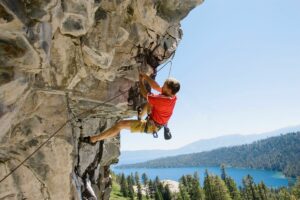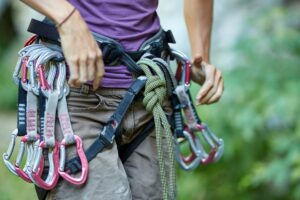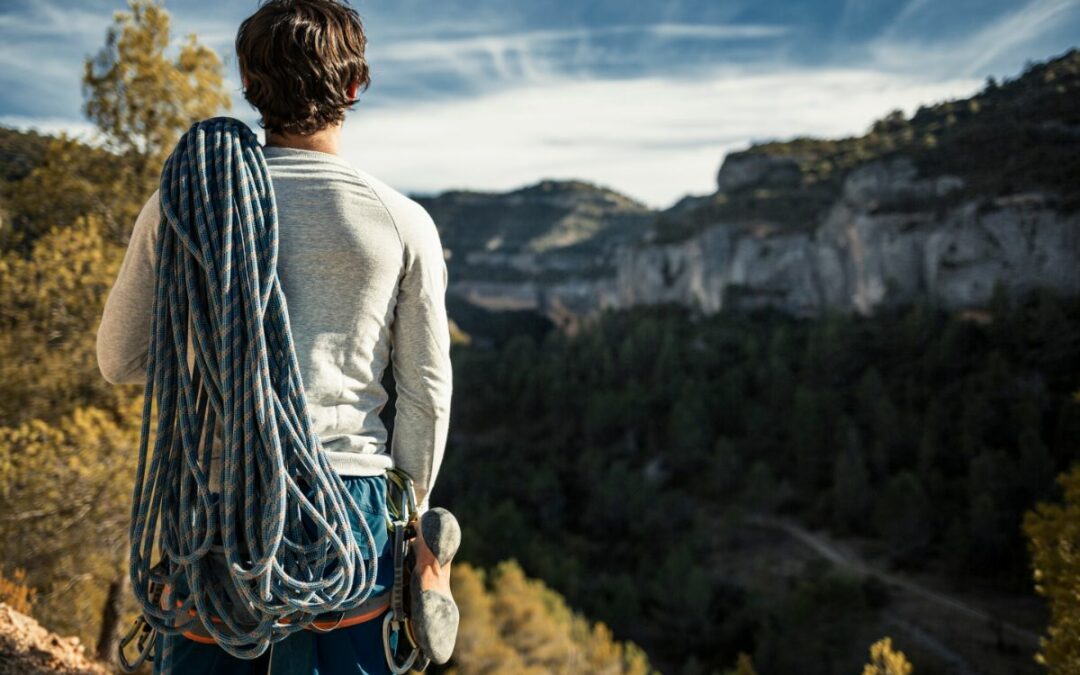Updated June 26, 2023 | Originally published June 8, 2020
Table of Contents:
- Climbing Gear That is Safe to Buy Used
- Climbing Gear You Shouldn’t Buy Used
- 5 Tips for Inspecting Used Climbing Gear
- MER: Southern Colorado’s Trusted Used Outdoor Gear Consignment Store
Whether you are a seasoned rock climber or trying to gear up for the first time, buying used climbing gear is a great way to keep the cost from scrambling up the rock ahead.
But if you are considering buying used climbing gear, remember this: you are only as safe as the equipment you choose.
Climbing equipment takes a lot of abuse and can get a ton of use by someone that enjoys being in the Colorado mountains. Climbing gear will get wet, baked by the sun, and deteriorate with age, all things to remember if you decide to buy used equipment. A single piece of equipment can hold your life in its hands.
New climbing gear can also cost a pretty penny, and (although veteran climbers may not believe it) climbing might not be for everyone. That leaves an opportunity to purchase gently or barely used equipment – and there are amazing deals on used gear. But just how safe is it?
Many Colorado mountain lovers are anxious to hit the great outdoors now that the temperatures are climbing. If you’re ready to buy some used climbing gear, here are some tips for making the safest choices.
Climbing Gear That is Safe to Buy Used
You can safely purchase some types of climbing gear second-hand, so long as you inspect them thoroughly and always buy from a reputable seller. Here are a few items to keep an eye out for:
 Chalk Bags
Chalk Bags
Chalk bags are vital equipment for any climber, and, no surprise, they are entirely safe to buy used! Just do a quick inspection to ensure the bag contains no rips or tears. You don’t want to reach into your bag and discover that you have left a chalk trail behind you where it will do you little good.
Climbing Apparel
You can also get some excellent bargains on climbing apparel, which is entirely safe to buy used. Whether looking for layering options or pants made specifically for climbing with stretchy material, reinforced knees, and articulated knees and gussets, purchasing used clothing is as good for your wallet as for the environment.
Climbing Shoes
One of the most popular pieces of used climbing gear you can buy is climbing shoes. These items tend to lose half their value as soon as they are purchased, and you can find some fabulous deals on used climbing footwear that someone has worn once or twice and then set aside for one reason or another.
So, if you can get past the idea of buying someone else’s shoes, your next step is to inspect them for quality. Once you find a pair that fits, you’ll need to inspect them to ensure you’re getting shoes that are safe for climbing. Check the seams to make sure they aren’t coming apart. Also, check the rubber on the bottom and avoid any deep cuts, gouges, or uneven wear.
Related: What Gear Do You Need to Climb a 14er?
Crashpads
The purpose of a climbing crashpad is to add a cushion between the climber and the ground to reduce the impact of a climbing fall. (Visit climbing.com and learn everything there is to know about them.)
When shopping for used climbing gear such as crash pads, exercise your best judgment regarding wear and tear. Look for signs of fading or other indicators that show significant age. Avoid purchasing pads that are ripped, cut, or otherwise damaged. Check all buckles, straps, and tie points before you purchase.
In short, climbing equipment not connected to the climber’s safety is generally safe to purchase used.
Climbing Gear You Shouldn’t Buy Used
While you can get plenty of good deals on used climbing gear, there are things you should always buy new. Your safety is too important to compromise for the sake of a few dollars.
Harnesses
A climbing harness is worn around the waist and legs to connect the climber to the rope. Harnesses literally hold your life on the line. No matter how well you inspect a used harness, there is no way to guarantee there is no hidden damage. However, consignment stores are still a great option as they also sell new gear that is often cheaper than other stores.
Helmets
A helmet protects the climber’s head from falling rocks or other debris. The maximum lifespan of a helmet with zero use is about ten years, and the useful life of a helmet with any use is about eight years. However, the integrity may be compromised if a helmet is involved in a fall. It can be damaged and its integrity compromised.
Even something dropping from above and striking a helmet can damage the internal structure. Furthermore, paint and stickers (adhesives) can degrade the plastic on a helmet. Be safe and buy a new one.

Ropes
A rope protects the climber by attaching to both the harness and anchors placed in the rock. If the climber falls, the rope will help to catch them. While you can technically buy used rope and not die, there is no real way to ensure that a rope hasn’t taken falls, been stored improperly, or had UV damage. For that matter, even the lack of use of a rope can be cause for concern. To err on the side of caution, spend a little extra and get new equipment.
Carabiners and Belay Devices
Carabiners are metal loops used to connect different pieces of climbing equipment. They can be used to attach the rope to the harness or the climber to anchors in the rock. Belay Devices control the rope while the climber ascends or descends.
The good news about hard climbing gear component goods like carabiners and belay devices is that metal gear can be more resilient than soft goods and have a long life span. However, new carabiners and belay devices tend to be close in price to used ones, so do yourself a favor and purchase these new ones.
5 Tips for Inspecting Used Climbing Gear
Before purchasing used climbing gear, perform a thorough inspection to ensure the equipment is safe. Specifically, look for the following:
- Fraying or wear: Check ropes, slings, and harnesses for fraying or signs of wear, such as thinning or discoloration. This can indicate that the gear is old, has been used heavily, or has been exposed to harsh weather conditions.
- Damage or deformities: Look for any cracks, dents, or other signs of damage on metal gear such as carabiners, cams, and nuts. Avoid gear that has been dropped or has visible deformities.
- Age: Check the gear’s age to ensure it hasn’t exceeded the recommended lifespan.
- Recalls: Check to see if the gear has been recalled, which could indicate a safety issue. You can usually find recall information on the manufacturer’s website or by contacting them directly.
- Only Buy from Reputable Sellers: Reputable resellers of outdoor gear typically have rigorous inspection processes to ensure that the gear they sell is safe to use. Buying from an unknown source (including Craig’s List, Facebook Marketplace, and your community garage sale) can be risky as you may not know the history or quality of the gear, which could lead to accidents or injuries while climbing.
MER: Southern Colorado’s Trusted Used Outdoor Gear Consignment Store
Yes, there are good deals on used climbing gear, so long as you follow the tips above and place safety above all else. When you purchase gently-used outdoor gear from MER, you know you are getting exceptional equipment that meets our consignment criteria.
Our reputation as Southern Colorado’s most trusted outdoor gear consignment shop ensures you receive a great selection of camping, backpacking, hydration, climbing gear, and so much more at unbelievably low prices. Stop by our store on Bott Street in Colorado Springs today to see what we currently have in stock. You won’t be disappointed!
MER. Great Gear. Greater Cause.

